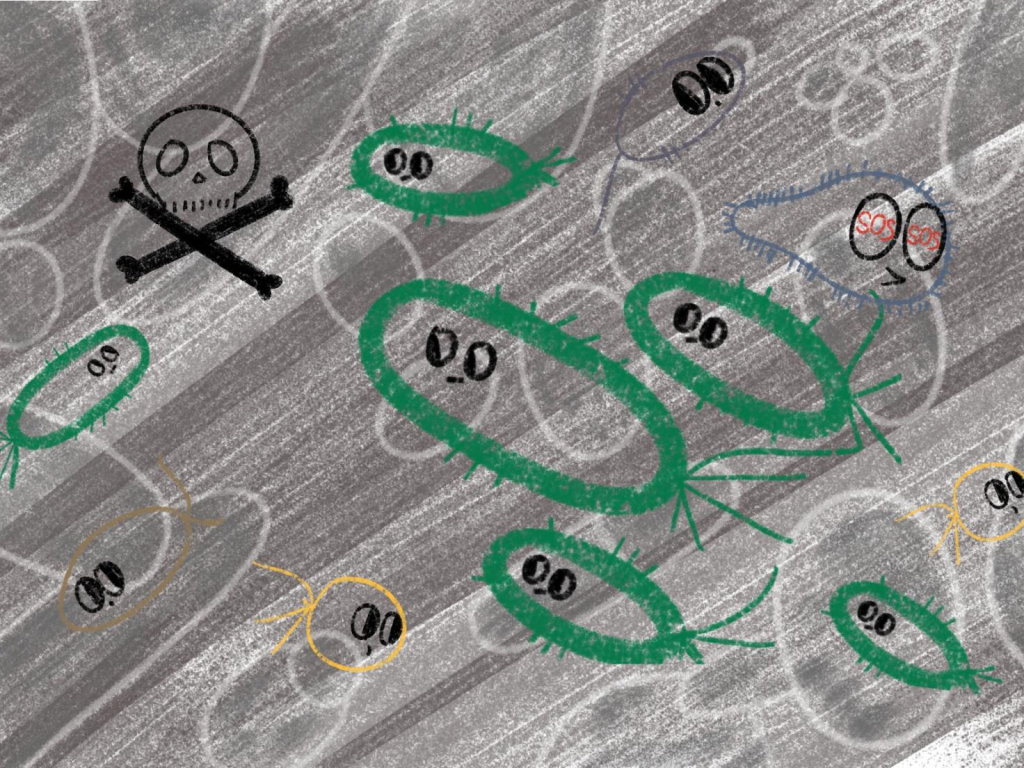It is a biological instinct to avoid harm, but sometimes reality is exactly the opposite. Recent research shows that Pseudomonas aeruginosa (P. aeruginosa), an opportunistic pathogen, tends to “move towards its death” under certain pressure. Scientists were also surprised by this unexpected finding at first. However, results of further experiments suggest that P. aeruginosa is not a daredevil but an aggressive warrior that actively fights against any potential competitor in the environment.
While most bacteria tend to avoid harmful chemicals in the environment, P. aeruginosa will take them as a signal of competitors and even fight them at the cost of life.

Oliveira, N.M., Wheeler, J.H.R., Deroy, C. et al. Suicidal chemotaxis in bacteria. Nat Commun 13, 7608 (2022).
As single-cell organisms, bacteria tend to flock together in an environment. To better communicate with nearby cells, better utilize nutrients, and better withstand adverse factors in the environment, many bacteria can produce extracellular polymeric substances, also known as biofilm. Antibiotics are chemicals used to treat bacterial infections. They work by either killing bacteria or inhibiting their growth. However, in a real environment, there is usually a mixture of different types of bacteria, leading to competition for space and nutrients. Thus, some bacteria can also release chemicals similar to antibiotics to fight their competitors as well as to protect themselves. Everything happens in the biofilm, where there is a gradient centered at bacteria that produce harmful chemicals and radially diffused towards their competitors. In order to cope with life under these conditions, bacteria have evolved a wide variety of physiological responses to detect and respond to toxic compounds. One of the key ways that bacteria respond to chemicals in their environment is via chemotaxis, the ability of cells to bias their motility in response to chemical gradients. However, there is no previous knowledge or evidence of chemotaxis in response to antibiotics. In this study, scientists focused on P. aeruginosa‘s movement in antibiotic gradients and explained its behavior in the real environment.
The idea of “fighting against other competitors” didn’t come into researchers’ attention at the beginning. Previous knowledge and inherent logic for survival influenced their judgment, and researchers started to think if there is any other factor that attracts P. aeruginosa to move towards a certain direction. The very first possibility they thought of was nutrient gradients. Researchers built up an artificial carbon source gradient and observed the movement of P. aeruginosa. At the beginning, cells did swim towards the area of higher carbon source levels. However, as the carbon source was gradually consumed, this reaction was also reduced and finally disappeared. In other words, nutrition is not the key factor leading to the continuous movement of P. aeruginosa. Then, naturally, researchers thought about the repulsion by non-cell chemicals. However, experiments showed that repulsion of chemicals triggered cell dispersion but not directional migration.
After a series of failures, scientists started to think from a new direction: What is the outcome of this kind of cell movement? The answer is clear: Cells migrate towards antibiotics and die. In this case, seeking nutrition or avoiding harmful chemicals seems to be meaningless at the cost of death. Then what motivated P. aeruginosa to be so proactive? There was only one hypothesis that hadn’t been verified: its ability to detect and respond to harmful competing bacteria. Researchers then introduced two competing bacteria, PAO1 and PA14, and generated antibiotic gradients around them. This time, P. aeruginosa moved steadfastly toward PAO1 and PA14, against the rising antibiotic gradient, and released its own harmful product along the way. More importantly, at the end of the experiment, the growth of competing bacteria PAO1 and PA14 was significantly inhibited, which strongly reflected the significance of this movement. P. aeruginosa is like the brave warrior that fights the enemy with its life.
Bacteria are the simplest organisms on earth. However, sometimes their actions are quite deliberate. Recently, scientists showed that P. aeruginosa has the ability to move towards competitors to engage in a counterattack. Rather than moving away from toxins, cells actively bias their motion to undergo chemotaxis towards lethal concentrations of antibiotics. Just as the study suggests, P. aeruginosa is a strong retaliator, a highly aggressive species that will attempt to eliminate competitive bacteria growing in its neighborhood.